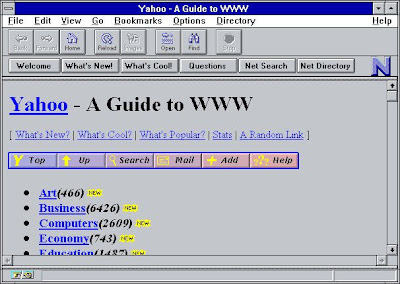Web Browsers From 90′s.
Twenty years ago this month (December) , Tim Berners-Lee created and tested the very first Web browser, WorldWideWeb. To commemorate this anniversary, let’s take a look back through the main Web browser launched from 1990 to 2008 .
WorldWideWeb (1990)
This is the world’s first Web browser. The earliest versions ran only on NeXTSTEP
ViolaWWW (1992)
ViolaWWW was the first Web browser for the Unix-based X Windowing System.
Cello (1993)
Cello was the first Web browser for Microsoft Windows (version 3.1, in fact).
Lynx 2.0 (1993)
CERN created the world’s second Web browser–the text-only “Line Mode Browser”–in 1990 so that the Web would be accessible across all platforms via Telnet.
NCSA Mosaic 1.0 (1993)
NCSA Mosaic brought the WWW to the general public’s attention, thanks to its ease of use, its presence on Windows and Macintosh platforms (Unix XWindows version shown here), and its ability to display images inline with text.
IBM WebExplorer (1994)
IBM broke into the Web browser field relatively early with the Mosaic-based WebExplorer, designed for the company’s OS/2 Warp 3 operating system. Critics hailed IBM’s browser.
Netscape Navigator 1.0 (1994)
After finding success with Mosaic, that browser’s creators left NCSA to form Netscape Communications, which developed Netscape Navigator 1.0.
Microsoft Internet Explorer 1.0 (1995)
Seeing Netscape’s success, Microsoft decided to jump into the browser business.
Netscape Navigator 3.0 (1996)
Here’s Netscape at the height of its popularity and influence–the period just before Internet Explorer stole the wind from its sails.
Opera 2.0 (1996)
Norwegian company Opera Software released the first public version of Opera browser, version 2.0, for Windows in 1996.
KDE Konqueror (2000)
Konqueror, both a Web browser and a file manager, debuted with the KDE 2 desktop environment for Unix-like systems in 2000. Its open-source rendering engine, KHTML, later became the basis for Apple’s Safari Web browser.
Microsoft Internet Explorer 5 for Mac (2001)
With the coming of the Mac OS X operating system, Apple needed a new Web browser.
Microsoft Internet Explorer 6.0 (2001)
The era of IE 6 marked the height of Microsoft’s browser dominance–as well as the height of its sloth and sloppiness in browser design.
Netscape 7 (2002)
Facing dwindling market share, Netscape released much of its code as open source in 1998.
Mozilla Phoenix 0.1 (2002)
From the ashes of the bloated Netscape and Mozilla Communications suites rose the lean and mean Mozilla Phoenix project.
Apple Safari Public Beta (2003)
Internet Explorer 5 for Mac–the Mac OS’s default browser up to 2003–was a buggy, slow embarrassment compared with learner alternatives arriving at the time.
Mozilla Firefox 1.0 (2004)
After enjoying years of popularity in its beta incarnations, Mozilla’s Firefox Web browser finally released as version 1.0 to great fanfare and impressive download numbers in 2004.
Google Chrome Beta (2008)
As if Google didn’t control enough of the Web already, in 2008 the search behemoth decided to release its own Web browser.
Which Web Browser From 90′s, you like most to use?
Labels: Information































